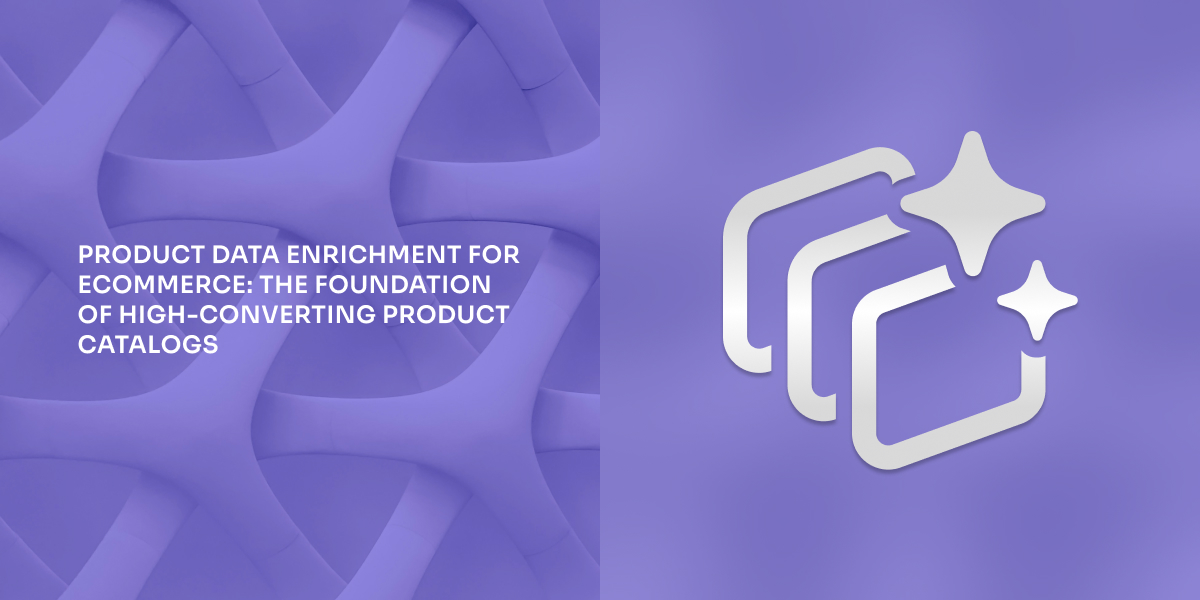Product data enrichment for ecommerce: the foundation of high-converting product catalogs

A writer-marketing assistant with a background in sociology and research, Alyanna is part of the marketing team at 1902 Software. As one of the newer members, she brings a fresh perspective and a growing curiosity about how technology helps businesses—especially in the B2B sector—connect with their audiences more effectively. She contributes to the team’s efforts in creating marketing materials and supporting initiatives for both 1902 Software and WriteText.ai.

In ecommerce, the difference between a product that converts and one that doesn't often comes down to the quality of its data. Yet many online retailers struggle with incomplete, inconsistent, or poorly structured product information that fails to connect with both search engines and shoppers.
That’s where product data enrichment comes in—turning ordinary listings into structured, search-ready product entries that improve visibility and sales.
Understanding product data enrichment vs. content generation
Before diving into implementation, it's crucial to distinguish between two related but distinct processes.
Product data enrichment involves enhancing existing product information by completing missing attributes, standardizing formats, correcting inconsistencies, and organizing data according to established taxonomies. Think of it as refining raw material you already possess—adding nutritional details to food products, specifying exact dimensions for furniture, or including care instructions for apparel.
Content generation, by contrast, creates new descriptive text, marketing copy, or visual assets from scratch. While both serve important roles in ecommerce, enrichment focuses specifically on structured data quality—the foundation upon which effective content is built.
According to research, 10% of purchase failures during checkout can be traced back to insufficient product information. This shows that ecommerce product data enrichment isn’t just a technical process—it’s a business-critical step that directly influences revenue.
The core components of product enrichment
Product enrichment breaks down into several key processes that work together to improve your data quality:
Attribute completion
Most product catalogs contain gaps—missing specifications, incomplete categorization, or absent technical details. Attribute completion systematically identifies these gaps and fills them with accurate, relevant information. For a clothing item, this might mean adding fabric composition, country of origin, or fit type. For electronics, it could involve specifying warranty periods, compatibility requirements, or energy ratings.
This structure also improves search visibility. Search engines rely on complete product attributes to display rich results in search. For instance, Google’s schema markup requires specific details like price and availability to show enhanced listings. Meanwhile, Google Merchant Center's data specification requirements also demonstrates how platforms prioritize complete, structured product information.
Normalization and standardization
Inconsistent data formats create friction throughout the ecommerce ecosystem. Consider three products listing dimensions as "15 x 10 x 8 inches," "15in x 10in x 8in," and "15" × 10" × 8"—all technically correct but systematically incomparable.
Product content enrichment through normalization establishes uniform formats across your catalog. This standardization enables:
-
Accurate faceted navigation and filtering
-
Meaningful product comparisons
-
Reliable data feeds to marketplaces and shopping platforms
-
Consistent display across multiple channels
Taxonomy mapping and classification
Taxonomy mapping aligns your products with recognized classification systems, including your internal categories and external frameworks like Google’s product taxonomy.
Proper taxonomy mapping ensures your camping tent appears in relevant searches for "4-person tents," "backpacking equipment," and "outdoor camping gear" rather than being buried in a generic "sporting goods" category. This hierarchical organization directly influences both on-site navigation and search engine understanding.
How enriched data transforms SEO performance
The relationship between ecommerce product data enrichment and search visibility operates through multiple mechanisms:
Enhanced semantic understanding
Modern search algorithms don't just match keywords—they interpret intent and context. Enriched product data provides the semantic signals search engines need to understand what you're selling, who it's for, and when it's relevant.
When a product listing includes comprehensive attributes—materials, use cases, compatible products, technical specifications—search engines can confidently surface it for long-tail queries that partially match those attributes. A "waterproof hiking backpack with laptop compartment" becomes discoverable specifically because those enriched attributes exist in structured form.
Structured data and rich results
Product schema markup requires clean, complete data. Product content enrichment ensures you can implement structured data that qualifies for rich results—those enhanced search listings with ratings, pricing, and availability that command significantly higher click-through rates.
Google's own research indicates that structured data implementation correlates with improved search performance, though they emphasize that quality content remains paramount. Enrichment provides quality content that makes structured data valuable.
Cross-channel consistency
E-commerce product data enrichment services often emphasize multi-channel distribution because enriched data maintains consistency across platforms. When your product appears on Google Shopping, Amazon, your own e-commerce site, and social commerce channels with consistent, complete structured information (such as specifications, pricing, and attributes), you build both algorithmic trust and consumer confidence.
Search engines notice when product information aligns across sources. This consistency signals reliability—a key component of Google's E-E-A-T framework that influences ranking decisions.
The conversion impact of product enrichment
While SEO benefits are measurable, the most immediate impact of product enrichment appears in conversion metrics:
Reduced purchase hesitation
According to the Nielsen Norman Group, users often abandon purchases when product pages lack critical details. Complete, enriched data helps shoppers make decisions faster by answering those questions before they ask them.
Improved filtering and discovery
Enriched attributes enable sophisticated on-site search and filtering. When customers can narrow results by specific dimensions, materials, compatibility, or features, they reach relevant products faster. This reduced friction directly correlates with higher conversion rates.
Enhanced product comparisons
Complete attribute data allows meaningful side-by-side comparisons. Shoppers evaluating similar products need standardized specifications to make informed decisions. Enrichment makes these comparisons possible and positions your catalog as authoritative.
Automating enrichment with WriteText.ai
Manual product data enrichment faces obvious scalability challenges. Enriching hundreds or thousands of SKUs requires systematic, automated approaches that maintain accuracy while operating at scale.
WriteText.ai addresses this challenge through intelligent automation that combines AI capabilities with ecommerce-specific understanding. The platform doesn't just generate content—it systematically enriches product data by:
-
Identifying and completing missing attributes. By analyzing product categories and industry standards. The system knows what attributes matter for each product type and ensures they're accurate and complete.
-
Normalizing formats and values across your entire catalog. Dimensions, colors, materials, and other attributes follow consistent rules that align with marketplace requirements and search engine preferences.
-
Mapping to appropriate taxonomies. Aligning both your internal categories and external classification systems like Google's product taxonomy, ensuring products appear in relevant contexts across all channels.
-
Maintaining ongoing enrichment as your catalog evolves. WriteText.ai's keyword optimization pipeline automatically enriches new products with relevant keywords and attributes from day one. The system analyzes search trends and weaves high-value keywords naturally into titles, descriptions, and specifications.
The platform integrates directly with major ecommerce platforms including Shopify, WooCommerce, and Magento, allowing enrichment to happen seamlessly within your existing workflow. Rather than exporting data, enriching it externally, and reimporting—a process prone to errors and delays—WriteText.ai operates natively within your commerce environment.
Implementing an enrichment strategy
Successful ecommerce product data enrichment requires systematic implementation:
-
Start with high-value products that drive significant revenue or traffic. Enriching your entire catalog simultaneously may not be practical, but improving your top performers delivers immediate measurable impact.
-
Establish clear attribute standards for each product category. Document what information must be present, how it should be formatted, and where it should appear. This documentation becomes the foundation for both manual and automated enrichment efforts.
-
Audit existing data to identify gaps and inconsistencies. 87% of consumers feel product content is the most important factor when deciding to purchase online—understanding your current state reveals what needs fixing first.
-
Leverage automation tools like WriteText.ai to scale enrichment beyond what manual processes can achieve. Automation doesn't replace human judgment but extends your capacity to maintain high-quality data across thousands of SKUs.
-
Monitor performance metrics that reflect enrichment impact—organic search traffic to product pages, conversion rates, cart abandonment rates, and customer service inquiries. BigCommerce data shows that product pages with complete information convert 2-3x better than those with minimal details.
Enrichment as competitive advantage
In an increasingly crowded ecommerce landscape, product data enrichment gives retailers a lasting competitive edge. Well-structured, consistent product information meets both algorithmic and human needs—boosting visibility, trust, and revenue.
The retailers who prioritize data quality establish themselves as authoritative sources. They appear in more searches, provide better user experiences, and convert browsers into buyers more effectively. This advantage compounds over time as enriched data feeds machine learning systems, personalization engines, and recommendation algorithms that drive ecommerce success.
With ecommerce product data enrichment services like WriteText.ai, maintaining this quality at scale becomes achievable. The platform automates ongoing product content enrichment, ensuring your catalog stays accurate, keyword-optimized, and conversion-ready.